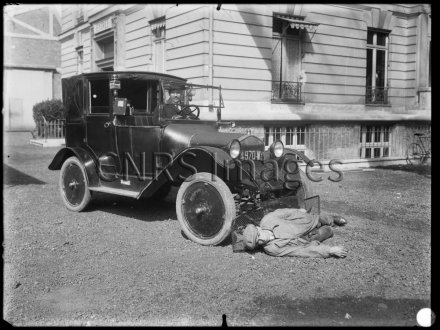Production year
1924

© Fonds historique / CNRS Images
19000001_0530
Taxi equipped with Louis-Auguste Laurenceau’s pedestrian protection device, Mechanics Laboratory, September 23, 1924. "The device consists of a metal chassis cove¬red by a protective grate and rubber cylin¬ders serving as shock absorbers", explains the inventor. He goes on to summarize its operation as follows: "A standing pedestrian involved in a collision with a vehicle running at 20 or 30 kph is first hit at ankle height. . . . The individual thus loses his or her balance and falls to the ground". Whether the colli¬sion occurs when the pedestrian is standing or lying on the ground, the victim is then pushed to the side. This would be the case of “a drunkard not able to be seen in time,” says the inventor. The sequences of images published in Recherches et inventions show the different types of prevention scenarios made possible with the protection device installed on a Ford car. Office national des recherches scientifiques et industrielles et des inventions.
The use of media visible on the CNRS Images Platform can be granted on request. Any reproduction or representation is forbidden without prior authorization from CNRS Images (except for resources under Creative Commons license).
No modification of an image may be made without the prior consent of CNRS Images.
No use of an image for advertising purposes or distribution to a third party may be made without the prior agreement of CNRS Images.
For more information, please consult our general conditions
1924
Our work is guided by the way scientists question the world around them and we translate their research into images to help people to understand the world better and to awaken their curiosity and wonderment.